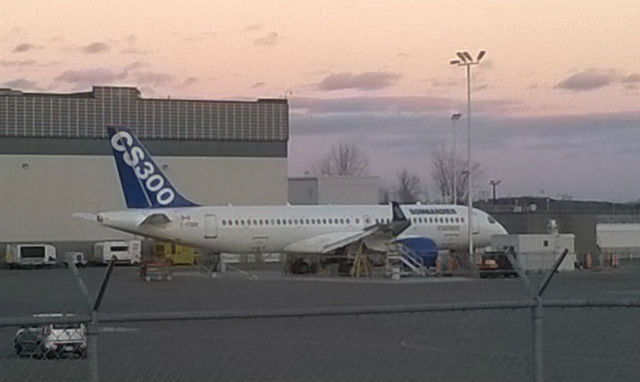On 16 November, the first Bombardier CS300 was glimpsed outside the factory for the first time. The stretched CSeries model is still within days or weeks of entering pre-flight taxi tests, but emerged to perform a battery of checks on its fuel flow system.

This particular CS300 is the sixth CSeries aircraft to enter final assembly and the fifth to emerge from the factory in Mirabel, Canada. Four smaller CS100s have already entered flight test, while a fifth remains in final assembly.
Bombardier says it still plans to complete first flight with the CS300 by the end of the year – “weather permitting”.
As it enters the flight test programme, the first CS300 will be operated by a commercial aviation division that is almost unrecognisable from the organisation that celebrated first flight of the CS100 only 14 months ago.
The scars of the first year of CS100 flight tests are still fresh. The test programme has suffered several stoppages, including a 100-day hiatus caused by the failure of a Pratt & Whitney PW1500G engine on the ground on 29 May. In the same year that the Airbus A350-900 and Boeing 787-9 racked up thousands of hours of flight testing, the CSeries managed only about 300. The completed tests were also compromised by the fly-by-wire system, which activated the normal mode for the first time only during October.
Amidst the slow progress on the flight test schedule, Bombardier’s management also went through upheaval. The Bombardier Aerospace segment is being dissolved into three standalone units, even as the company sheds thousands of administrative and management staff.
After such a year, it may seem that the only direction the company can move is up, and the CS300 is to become a symbol of a new sense of momentum introduced by a reorganised global sales team led by a new executive; Ross Mitchell.
In August, Mitchell was given responsibility for an organisation that combines communications, public relations, product marketing, sales operations, deal management and strategy. In early November, Bombardier’s asset management, which oversees trade-ins and used aircraft, was added to his portfolio.
“It’s a compilation of all the internal functions that are part of the sales process,” Mitchell says in an interview with Flightglobal. “They are all now combined together to work toward the single goal to ensure we are selling aircraft and doing what’s best for our customers. It’s meant to make sure there is better communication within the company.”
Bombardier’s CSeries sales record seems modest, with a firm order backlog of 243 aircraft, including 180 CS300s and 63 CS100s. But the modest appearance only reflects the scale of narrowbody rivals Airbus and Boeing, which have thousands of backlogged orders for mostly larger aircraft. Bombardier has always maintained a goal of achieving 300 combined firm orders for the CSeries family at entry into service of the CS100 in the second half of next year.
The beginning of flight tests of the 135-seat CS300 is expected to drive a new wave of interest for what should be the most popular model in the family.
“I would expect it to get more action, and attention does drive some customer behaviours,” Mitchell says.
Lufthansa subsidiary Austrian Airlines has been named as a possible buyer for 16 CSeries aircraft in the near-term. Lufthansa has already signed a firm order for 30 CSeries for subsidiary Swiss, and that order includes options.
“With Austrian being a part of the Lufthansa group, there are certainly options available,” Mitchell says. “The fact that those options exist leaves us well positioned for further business in the Lufthansa group. The options are owned by Lufthansa. They could put them into any one of the brands that they own.”
Unlike Airbus and Boeing’s vast narrowbody assembly operations, Bombardier is starting up the CSeries lines from scratch in a new factory still being erected in Mirabel. As a result, customers have to be willing to wait longer to receive their aircraft.
“I don’t like to talk too much about the skyline,” Mitchell says. “But we have pretty full skylines at this point. Early deliveries wouldn’t be easy to come by now. I think we’ve had demand that has filled up early positions. We would try and be competitive with respect to whatever transaction would come up, recognising we would still have to be mindful of whatever our production options are.”
Source: Cirium Dashboard























